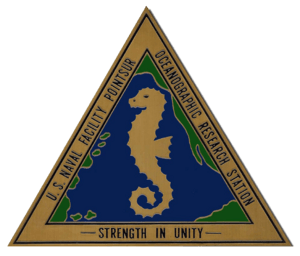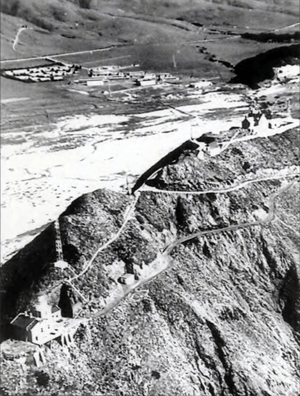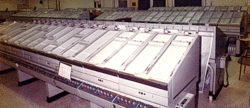Naval Facility Point Sur facts for kids
Quick facts for kids Naval Facility Point Sur |
|
|---|---|

NAVFAC Point Sur logo
|
|
| Active | January 1958 - October 1984 |
| Country | United States of America |
| Allegiance | |
| Branch | U.S. Navy (Sound Surveillance System) |
| Size | 10 officers, 96 enlisted personnel, and 18 civilians |
| Part of | Oceanographic System Pacific (after 1964) |
Naval Facility Point Sur was a secret U.S. Navy base built during the Cold War. Its main job was to listen for Soviet submarines using a special underwater sound system. This system was called the SOund SUrveillance System (SOSUS).
The base was located near Point Sur, California, on the beautiful Big Sur coast. It opened in 1958. To keep its real purpose a secret, the public was told that the station was doing "oceanographic research."
Naval Facility Point Sur was very important in finding the sunken Soviet submarine, the K-129. This discovery was a big win for U.S. intelligence. The base closed in 1984 because its operations became computerized. Most of its buildings were later given to California State Parks.
Contents
During World War II, the U.S. Navy experimented with early sonar and radar near Point Sur. Later, in 1949, Navy scientists found a way to detect submarines from far away using underwater microphones called SOFAR hydrophones. This technology became very important during the early Cold War, when the Soviet Union had a very large submarine fleet.
How Did the Base Work?
The U.S. Navy placed long lines of hydrophones (underwater microphones) on the ocean floor. These hydrophones were connected by cables to shore bases, which were called "Naval Facilities" (NAVFACs). At these NAVFACs, special equipment processed the sounds. This equipment was known as the Low Frequency Analyzer and Recorder (LOFAR) system.
The first SOSUS hydrophone lines were placed at the edge of the continental shelf, about 650 feet (200 meters) deep. They pointed out into the deep ocean. Cables at the time couldn't be too long, so NAVFACs had to be built close to where the deep ocean was near the coast. Point Sur was a perfect spot because it had a deep underwater canyon close to shore.
NAVFAC Point Sur was built in 1957 and officially opened on January 8, 1958. It was located next to the Point Sur Lighthouse, about 25 miles south of Monterey, California. It was a self-sufficient base, meaning it had everything its personnel needed.
Keeping the Mission a Secret
The real mission of SOSUS and its bases was kept secret until 1991. This means it was a secret for the entire time NAVFAC Point Sur was operating. The construction and maintenance of these bases were done under a non-secret name, "Project Caesar." The official cover story was that these bases were for "oceanographic research," which is what the sign at the entrance of NAVFAC Point Sur said.
NAVFAC Point Sur was part of a global network of shore stations. These stations used underwater hydrophones to track the movements of Soviet submarines. In 1964, it became part of the Oceanographic System Pacific command. The base had about 10 officers, 96 enlisted personnel, and 18 civilians. Their job was to "detect, classify, and report" Soviet submarines to help with anti-submarine warfare.
What Facilities Were at the Base?
Besides the main building where the cables ended and operations happened, the base had many other buildings. These included an administration building, a gym, a bowling alley, a movie theater, and clubs for the enlisted personnel and officers. There was also housing for families and single men.
Awards and Recognition
During its 26 years of operation, NAVFAC Point Sur received several awards. In 1969, it earned the Meritorious Unit Commendation. It also won the Efficiency "E" award in both 1977 and 1983. In 1983, it was even named the top Naval Facility by its command, winning awards for its operations, maintenance, and efficiency.
Finding the K-129 Submarine
NAVFAC Point Sur played a very important role in finding the wreck of the Soviet submarine K-129. On March 8, 1968, this submarine sank in the ocean northwest of Hawaii. The Soviet navy searched for months but couldn't find it.
The staff at Naval Facility Point Sur was asked to check their acoustic data. They found a unique sound on their LOFAR recordings that matched an implosion event on that date. With this information, other NAVFACs on the U.S. West Coast and in Alaska (NAVFAC Adak) also found the same sound event. This discovery led to a top-secret recovery program called Project Azorian. Through this project, the United States Central Intelligence Agency (CIA) managed to recover a part of the submarine. The CIA considered this one of the biggest intelligence successes of the Cold War.
Changes and Closure
NAVFAC Point Sur closed down on October 1, 1984. By then, its operations had become computerized. The data it used to receive was sent to another NAVFAC at Centerville Beach, California, about 260 miles north of San Francisco. Later, in 1993, data from Centerville Beach was sent to NAVFAC Whidbey Island in Washington.
By the 1980s, technology had improved. This meant that many shore stations could be combined into larger processing centers. This saved money, especially on staff costs, and allowed for more centralized data analysis. In 1985, after Point Sur closed, the entire SOSUS system was renamed the Integrated Undersea Surveillance System (IUSS) to include new mobile sensor systems.
What Happened to the Base After It Closed?
When the Cold War ended, the U.S. Navy started allowing scientists to use the SOSUS system for research. In 2007, oceanographers from the Naval Postgraduate School suggested that the Navy could use the Point Sur site for training. They believed it would help commanders learn more about the ocean and how sound travels underwater.
Scientists also thought the site could be used for other research. Geologists could study underwater earthquakes and volcanoes. Marine biologists could listen to whales and other sea animals to learn about their migration and habitats. They estimated it would cost about $10 million to reopen the labs, but the Navy did not approve the idea.
Current Status of Point Sur
Today, almost all of the Naval Facility Point Sur buildings have been given to the California State Park system. This happened in 2000, and the site became part of Point Sur State Historic Park. The state park no longer uses the buildings for housing.
As of October 2019, the facility is open to the public for special guided tours on Saturdays and Sundays.
In 2017, Naval Facility Point Sur was nominated to be added to the National Register of Historic Places. It was chosen because it is one of the last remaining SOSUS facilities, and the only one left on the West Coast.



